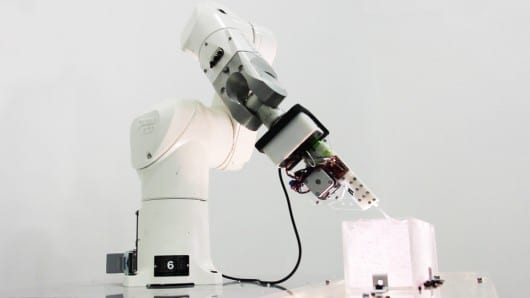
- Image via Wikipedia
A detailed, functional artificial human brain can be built within the next 10 years, a leading scientist has claimed.
Henry Markram, director of the Blue Brain Project, has already simulated elements of a rat brain.
He told the TED Global conference in Oxford that a synthetic human brain would be of particular use finding treatments for mental illnesses.
Around two billion people are thought to suffer some kind of brain impairment, he said.
“It is not impossible to build a human brain and we can do it in 10 years,” he said.
“And if we do succeed, we will send a hologram to TED to talk.”
‘Shared fabric’
The Blue Brain project was launched in 2005 and aims to reverse engineer the mammalian brain from laboratory data.
In particular, his team has focused on the neocortical column – repetitive units of the mammalian brain known as the neocortex.
“It’s a new brain,” he explained. “The mammals needed it because they had to cope with parenthood, social interactions complex cognitive functions.
“It was so successful an evolution from mouse to man it expanded about a thousand fold in terms of the numbers of units to produce this almost frightening organ.”
And that evolution continues, he said. “It is evolving at an enormous speed.”
Over the last 15 years, Professor Markram and his team have picked apart the structure of the neocortical column.
“It’s a bit like going and cataloguing a bit of the rainforest – how may trees does it have, what shape are the trees, how many of each type of tree do we have, what is the position of the trees,” he said.
“But it is a bit more than cataloguing because you have to describe and discover all the rules of communication, the rules of connectivity.”
The project now has a software model of “tens of thousands” of neurons – each one of which is different – which has allowed them to digitally construct an artificial neocortical column.
Although each neuron is unique, the team has found the patterns of circuitry in different brains have common patterns.
“Even though your brain may be smaller, bigger, may have different morphologies of neurons – we do actually share the same fabric,” he said.
“And we think this is species specific, which could explain why we can’t communicate across species.”
Related articles by Zemanta
- The quest to simulate a human brain (guardian.co.uk)
- Virtual Neurons Acting Like the Real Thing – The Blue Brain Project (singularityhub.com)
- Blue Brain Models Mammalian Organ Inside Computer (medgadget.com)
- Building a Brain on a Silicon Chip (technologyreview.com)
![Reblog this post [with Zemanta]](http://img.zemanta.com/reblog_b.png?x-id=06590ec1-ae40-4f13-bc07-da04d898895e)









